A POTTED HISTORY OF WRITING FURNITURE
Concern over the comfort, and indeed the integrity of the scribe did not materialise in England until the 17th Century. Until then he was considered a mere artisan who performed his work for the church or nobility. It is therefore not surprising that the first ‘Deske’ was in fact merely a sloping box on which the scribe could write and in which he could store his writing tools. These portable writing boxes were never larger than 3ft wide with a sloping hinged top which was placed on a table or bench when in use. (The first recorded mention of a Deske appears in Palladius’ De Re Rustica in about 1450. A similar desk can be seen in Lincoln Cathedral.)
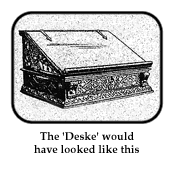
As in most English furniture of the period, oak was the most commonly used wood but fashions began to change following the Restoration in 1660 when not only did walnut replace oak as the material of choice but writing furniture was now more usually fitted with bases. Slowly, the sloping box developed to have its own stand. This was first removable, where the cabinetmaker disguised the join, and later became fixed. This sloping box on stand is now commonly known as the ‘Clerk’s Desk’ whilst a sloping desk with drawers below is now known as a ‘Bureau’. At first the term bureaux described other types of furniture such as low chests of drawers and dressing tables but by 1700 the term was finally accepted as describing writing furniture.
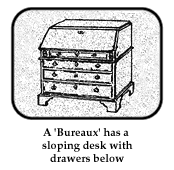
The ‘Bureaux Table’ arrived in England from Europe in about 1660. Originally the term described a surface supported by two turned legs at the rear and four at the front, two of which swung out as gate legs to support a flap. From France in the late 17th Century came the ‘Bureau-Cylinder’ and ‘Roll-Top Bureau’ now more usually referred to as a ‘Roll-Top’ or ‘Cylinder Desk’. The Cylinder Desk has a rounded lid which rotates into the desk whilst the ‘Tambour’ or ‘Roll-Top’ has its top enclosed by a sliding curved lid made from a number of wooden slats glued to a cloth base which allows it to roll down.
It was in about 1650 that gentle folk began to spend their time writing and performing their own clerical work and this led to a greater demand for more versatile forms of writing furniture.The result was the ‘Secretaire’ – a piece of furniture where the writing compartment is fronted by a flap or false drawer hinged on the lower edge so that it stands upright when closed.The flap is opened downwards so that when flat it becomes a large writing surface.
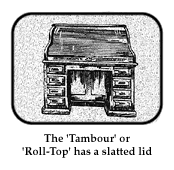
About 1700 the ‘Knee-Hole Writing Table’ or ‘Desk’ was developed which allowed the writer freedom of movement and comfort without loss of storage capacity. Sometimes there is a cupboard at the back of the knee -hole cavity to provide even more storage space. The term ‘Bonheur du Jour’ applies to a ladies writing desk and first appeared in about 1760. These highly desirable items were very popular during the reign of Louis XVI and featured a very delicate design with long tapering legs and usually a recessed superstructure containing a number of drawers for writing implements and personal effects. Also in France during the same period the ‘Bureau Plat’ achieved much popularity especially in the chateaux of rural France. They are large pieces of furniture, highly decorative, featuring a long table with an elegant and often ornate writing surface on four carved legs. The ornamentation was sometimes of marquetry, ormolu or bronze mounts and often in combination.
Almost a century later during the Regency period in England the ‘Writing’ or ‘Library Table’ became popular as a fine, usually mahogany table, with turned and sometimes fluted legs. Chippendale introduced some of the most innovative designs for writing tables and desks. Gothic ornamentation was still in favour but he thought that plain cabriole legs, as well as Ogee bracket feet were more elegant than those of pillar form. The serpentine shaped table with a circular recess for the knees with a cupboard behind he rather complicatedly described as the ‘Commode- Buroe-Table’ in his Director of 1762.
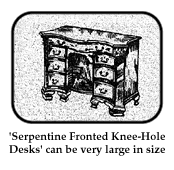
This would now be known as a ‘Serpentine Fronted Knee-Hole Desk’. These library tables, which Chippendale supplied to some of the greatest houses in the land, were often large in size averaging 6ft wide and 4ft deep.

The trade catalogues of this period also illustrated other lighter forms of writing tables. A very sought after form, often had ingenious mechanisms for supporting and altering the angled ‘drawing’ surface, is the ‘Architect’s Table’, versions of which can still be seen in draughtsmen’s offices to this day. Even ordinary writing desks of the late 18th Century became very elaborate. Filing systems were introduced in the form of ‘Pigeon Holes’ with letters of the alphabet over them. Others had special drawers for ink and sand. Mahogany writing tables without a superstructure for books were also made during this period. Those with circular or many sided tops are known as ‘Rent-Tables’ and these were still made in the early 19th Century. These eventually evolved into drum tables with a pedestal base sometimes having labelled drawers used for storing documents relating to the estate.
Robert Adam’s designs of the 1770’s changed the style of architecture and furniture to the neo-classical. He introduced rosewood and satinwood along with delicate inlay instead of elaborate carving. Chippendale and Adam co-operated in producing some of the finest examples of marquetry to be found in English furniture. The art of marquetry involved both the architect/ designer and the cabinetmaker in producing the best examples but others produced similar effects without carved embellishments, instead depending on carefully contrasted veneers.

The makers Hepplewhite and Shearer advanced this method along with the reduction of ornament and a greater severity of line. They also adapted the pedestals so that sometimes one remained as drawer unit whilst the other became a cupboard. these were sometimes double sided or double depth and are now known as ‘Partners’ Desks’ and used where two people needed to sit opposite each other.
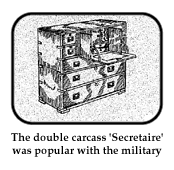
Large varieties of shapes and styles were introduced – serpentine sides, oval tops, bow-fronts with inlays and carvings etc. These were the forerunners of many of today’s pedestal and knee-hole writing desks. One of the more unusual examples was the ‘Register Desk’, which has a sloping writing surface in the centre above a fitted well with a small bank of draws on each side. The flush and sometimes ‘Double Carcass Secretaire’ became popular with the military where space was at a premium and furniture was shipped off around the world. Another was the ‘Wooton Desk’ which opens to reveal many interior drawers and a fold down writing surface.
There are a variety of other types of writing furniture whose designs resulted from the specific requirements of their users. Some origins have been lost in the mists of time, whilst others are still known. One, for instance, is the ‘Davenport’ – a very small and narrow slope-topped bureau. It is believed to have been made originally for the sea-going Captain Davenport by Gillows of Lancaster with its small size particularly suited to the confined spaces aboard ship. Another is the ‘Carlton-House’ desk where the writing surface is surrounded by a decorative bank of shaped drawers. The first known type is supposed to have been originally in the Prince Regent’s bedroom at Carlton House.
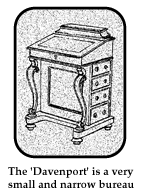
The styles of desks and other writing furniture have changed over the years especially with the Victorians and their descendants. However, the value still lies for current users in the knowledge that the designs, materials and workmanship of yesteryear are unparalleled today.
